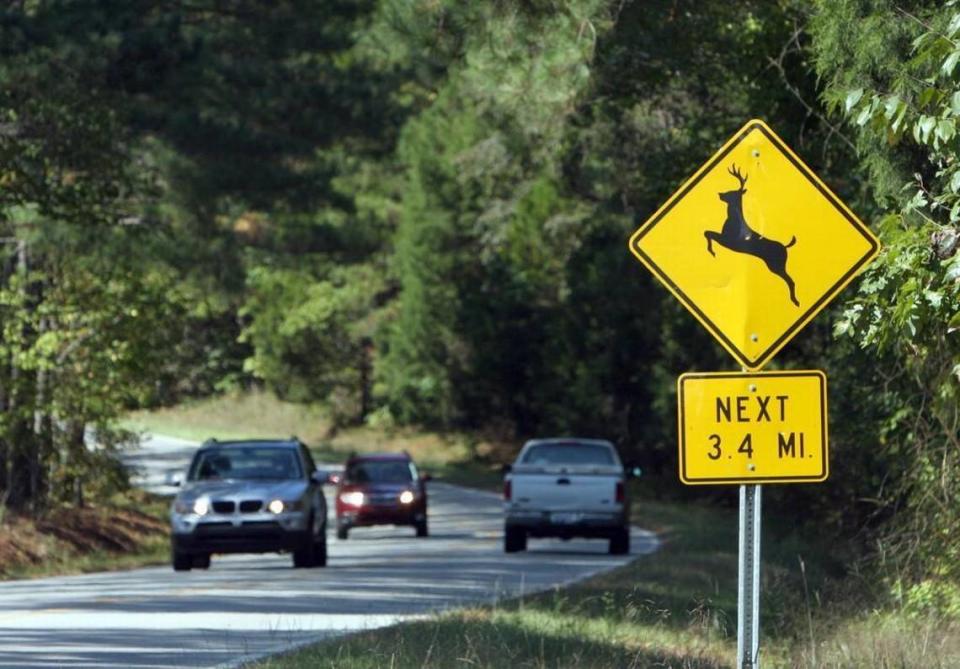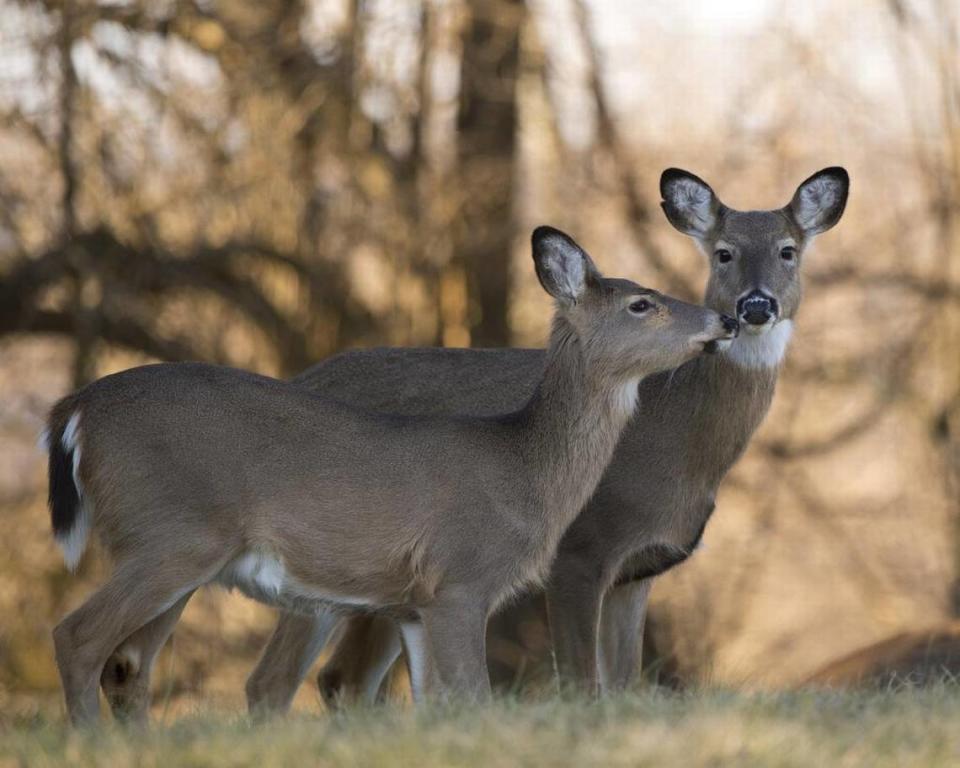Deer are on the move in NC now. Here’s how to do your best to avoid a collision
When Deer Mating Season meets Deer Hunting Season, we get Watch Out for Deer Crossing the Road season — a season that can be dangerous, expensive and traumatizing for all involved.
A North Carolina Department of Transportation study, looking at 2017 through 2019 data, showed that animal-related crashes in the state killed five people, injured more than 2,800, and caused nearly $156.9 million in property damage during that three-year period.
NCDOT said last year that the number of animal-vehicle crashes in the state in increasing, with the 2019 figure reaching 20,331 cases (the latest data available).
The state attributes the increase in crashes to North Carolina’s population growth, which means more drivers on the road and also more development, which “pushes animals — primarily deer, which account for about 90 percent of all animal-related crashes — into more opportunities for a dangerous encounter with vehicles.”
We talked to Moriah Boggess, a deer biologist with the North Carolina Wildlife Resources Commission, to learn more about deer movement this time of year, how to avoid dangerous deer-vehicle encounters, and what to do if a dreaded deer collision occurs.
What time of year do most deer-related collisions occur?
Deer vehicle collisions peak in North Carolina in October through December.
“Typically, vehicle collisions peak within a few days of the peak of deer breeding season, driving the increase of deer movements, which results in more vehicle collisions,” said Boggess.
That starts in early October in the eastern part of North Carolina and goes to mid-December in the western part of the state.
In the Triangle area, peak deer mating season is around November 8 to 10, said Boggess. Mark your calendars.

What time of day are deer most active?
Deer are crepuscular animals, which means they are most active during the twilight period.
That means most deer-vehicle collisions typically happen in early mornings and late evenings, peaking right around sunset, Boggess said.
Some deer do move around during the daytime, he added, but collisions don’t occur as often then because we can see the deer better, and they can see us better, so it’s a little easier to avoid them.
But “right at the edge of dark” is when they move the most, Boggess said. Unfortunately, people are also pretty active during that time of day, especially now with days getting shorter and commutes happening around sunrise and sunset.
Which roadways have more deer traffic?
In most cities, Boggess said you’ll start to see a lot of deer activity as soon as you get out of the downtown areas and head more toward neighborhoods and suburbs.
But deer are present almost everywhere.
“From county dirt roads to interstates, deer collisions can happen and do happen,” said Boggess.
Here are some roadways where we should pay most attention.
▪ Rural roads, interstates. It’s no surprise that deer are abundant along rural roadways, but they are also present along busy Interstates. There are fences along the sides of interstates that deter deer movement, Boggess said, but deer do cross those fences and attempt to cross interstates.
▪ Woods on both sides of the road. “If you’re driving through a neighborhood and suddenly there are patches of woods on both sides of the road, a lot of times that’s a good indication that it could be a corridor for deer movement,” Boggess said.
“Any area where an urban interface is broken up by forested cover,” he said.
▪ River and creek corridors. Boggess said deer also travel along a river or creek corridor, so if you know you’re driving in area near rivers and creeks, be more cautious.

How can you avoid hitting a deer?
▪ Actively look for deer. Keep an eye out for deer while you’re driving, Boggess said. Don’t be distracted while driving; scan the sides of the road while driving.
▪ Slow down. Slow way down. If you do see a deer, Boggess said, “slow way down.”
“I mean slow enough down, even if you’re on an interstate, down to 30 miles per hour or whatever you can safely do with the flow of traffic, but slow down as much as you possibly can.”
▪ Why so slow? Deer travel in groups. The reason Boggess wants us to “slow way down” is because when we see a deer cross the road, there could be other deer following behind.
“Oftentimes someone will hit a deer because they see one cross the road and they think they’re clear, and they keep going,” Boggess said. “They might even be paying attention to the deer that just crossed the road and they don’t see another deer coming in that same group.
“When you see one deer you need to slow way down because often there are more deer nearby. And when one deer is across the road, the one behind can become frantic and think it’s being left behind, and it can dart across the road.”
▪ Light up the roadside. Using your high beams is a great way to illuminate a larger area around the roadway and see deer before they enter the road. But only use your high beams when it’s safe to do so (when other cars are not approaching).
▪ Light up your grill. Research published last year in the scientific journal Echosphere shows that placing a small light bar on the front of your car that shines back onto the grill of your car will help deer see you and help them get out of your way.
When deer are in the road and a car is approaching, “they just see two little dots coming at them fast, and their depth perception is thrown off,” Boggess said. To a driver, it looks like the deer is frozen, but they’re just trying to figure out what’s going on, he said.
Boggess explains: “They see you better and realize something large is coming at them, and that actually did reduce the likelihood of deer-vehicle collisions quite a bit, because deer were able to actually react instead of just seeing two little white dots way off in the distance.
“It’s the only effective way so far that anyone has shown to reduce deer-vehicle collision rates,” he said.
▪ Whistles don’t work. On a related note, those little whistles that some people mount on their front bumpers to ward off deer? “They’re not effective,” Boggess said.
What should you do if you hit a deer?
If you hit a deer, you should call your 911, Boggess said. You may need assistance for yourself or for the injured deer.
While waiting for the authorities, the best thing to do, says Boggess, is give the animal space.
“Even if it’s mortally wounded and it’s dying, the best thing to do is stay back, otherwise you’re just stressing it out and adding to its stress level,” he said.
Are there more deer out and about this year?
Even though last year’s pandemic shutdowns gave some parts of nature a chance to heal and expand, the deer population likely was not affected.
“Miles traveled per month were pretty far down last March and April during the initial shutdown and work-from-home recommendations at the beginning of the pandemic,” Boggess said.
“But by the time we got to late summer and fall of last year, miles traveled per roadway were pretty comparable to most years and on par with the average, and that’s when the majority of deer collisions occur.
“There should be no significant change in the deer population this year compared to last year or the year before,” he said.

